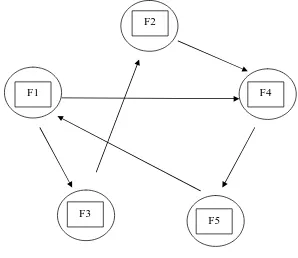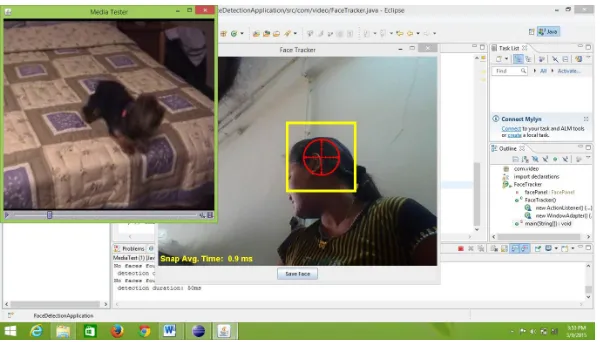Technology (IJRASET)
Real-Time Face Detection Application
Sayali Pokale1, Vijaya Bale2, Harsha Kharat3, Rohini Korulkar4Computer Department, NBN Sinhgad School of Engineering, PuneUniversity
Abstract— Face Detection is one of the challenging problems in image processing and it plays an important role in variety of
applications. There have been various approaches proposed for Face Detection Based On template matching facial features knowledge based methods etc. Among the proposed face detection methods, those based on skin color information is an important category. This project proposes a novel technique for detecting faces in color images. Color is a powerful fundamental cue of human faces and color information is an effective feature and is widely used in image processing and analysis.
I. INTRODUCTION
Different aspects of human physiology are used to authenticate a person’s identity. The science of ascertaining the identity with respect to different characteristics trait of human being is called biometrics. The characteristics trait can be broadly classified into two categories i.e. physiological and behavioural. This paper present and improve color based segmentation technique to segment the skin regions in a group picture and use of skin based segmentation in face detection. Skin based segmentation has several advantages over other face detection techniques like this method is almost invariant against the changes of size of face , orientation of face. The primary aim of skin based segmentation is to detect the pixels representing the skin regions and non- skin regions. After detection of pixels which represent the skin region, the next task is to classify the pixels which represent the faces and non faces. This paper present and improve color based segmentation technique to segment the skin regions in a group picture and use of skin based segmentation in face detection. Skin based segmentation has several advantages over other face detection techniques like this method is almost invariant against the challenges of size of face orientation of face. The primary aim of skin based segmentation is to detect the pixels representing the skin regions and non-skin regions. After detection of pixels which represents the skin regions, the next task is to classify the pixels which represent the faces and non faces. Face detection is an interdisciplinary field which integrates different techniques such as (i) image processing, (ii) pattern recognition, (iii) computer vision, (iv) computer graphics, (v) physiology, and (vi) evaluation approaches. In general, the computerised face recognition or face detection includes four steps. (i) face image is acquired, enhanced and segmented. (ii) face boundary and facial features are detected. (iii) the extracted facial features are matched against the features stored in the database. (iv) the classification of the face image in one or more persons is achieved.
II. BASIC CONCEPTS
Furthermore, colour information is invariant to face orientations. However, even under a fixed ambient lighting, people have different skin color appearance. In order to effectively exploit skin color for face detection, a feature space has to found, in which human skin colors clusters tightly together and reside remotely to background colors. Color model is to specify the colors in some standard, Some of the color models used is RGB color model for color monitors, CMY and CMYK model for color printing. HSV color model is the cylindrical representation of RGB color model. In each cylinder the angel around the central vertical axis corresponds to “hue” or it form the basic pure color of the image, the distance from the axis corresponds to “saturation” or when white color and black color is mixed with pure color it forms the two different form “tint” and “shade” respectively, and the distance along the axis corresponds to HSV color model is the cylindrical representation of RGB color model. The HSV model describes the color similarly to how the human eye tends to perceive color. RGB defines color in terms of a combination of primary colors, where as , HSV describes color using more familiar comparisons such as color, vibrancy and brightness. The color camera, on the robot, uses the RGB model to determine color. Ones the camera has read these value, the converted to HSV value. The HSV values are then used in the code to determine the location of a specific object or color for which the robot is searching. The pixels are individually checked to determine if they matched predetermined color threshold.
III. RELATED WORK
Technology (IJRASET)
There are different standard face databases available in internet. This section shows some of the standard face databases.
B. Yale Database
It consist of set of standard 165 black and white images of 15 different people (11 images per person) taken from Yale university standard database for use in facial algorithm. All the images are properly aligned and taken in same and good lighting and background conditions. Resolutions of each image are taken as 320x243 pixels.
C. Extended Yale Database
It contains 16128images of 28 human subjects under 9 poses and 64 illumination conditions.
D. FERET Database, USA
The database contains 1564 sets of images for a total of 14, 126 images that includes 1199 individuals. All the images are of size 290x240. This database was cropped automatically and segregated into sets of 250 female and 250 male faces. Face detection can be regarded as more general case of face localization. In face localization , the task is to find location and sizes of a known number of faces. In face detection , one does not have this additional information. Face detection is the essential front end of any face recognition system, which locates and segregates face regions from cluttered images, either obtained from video and still image.
IV. SYSTEM FUNCTIONS
[image:3.612.141.439.362.620.2]Here in our application we are going to detect face from live image by using skin color. The user is in no need to have technical knowledge to use this application. We will use swing to develop our system. Skin based segmentation has several advantages over other face detection techniques like this method is almost invariant against the changes of size of face, orientation of face. The primary aim of skin based segmentations Is to detect the pixels representing the skin regions and non skin regions. After detection of pixels which represent the skin region, the next task is to classify the pixels which represent the faces and non faces.
Fig 1. Dependency graph
Color model is to specify the colors in some standard. Some of the color models used is RGB color model for color monitors, CMY and CMYK model for color printing. HSV color model is cylindrical representation of RGB color model. In each cylinder, the angle around the central vertical axis corresponds to “hue” or it form the basic pure color of image, the distance from the axis corresponds to “saturation” or when white color and black color is mixed with pure color it forms two different form “tint” and “shade” respectively.
F1
F2
F4
F3
Technology (IJRASET)
V. SYSTEM OUTPUT
[image:4.612.163.460.198.363.2] [image:4.612.162.462.524.695.2]We proposed a face detection system which have graphical user interface from that we on our camera and watch a live video. By using skin color algorithm system show face from that video face detection algorithm that is able to handle a wide range of variations in static color images, best on a lighting compensation technique and color transformation with higher accuracy. Here in our application we are going to detect face from live video by using skin color. By using this, face detection technique we also developed a system, in that system we give input as any video then our face detection technique detect the face bye using system camera, after the face detection that video will be play or pause. That is if the face detection technique detect full face of user then video will be play continuously. The following figure shows the how system work actually at the run time. In the following figure face tracker detect the face of user and then video will play.
Fig 2. Output 1
If the system detect full face of the user then video will play and if the user face slightly turn face in left and right or up and down or user will not in front of the system camera then camera does not detect the face of the user at that time the playing video automatically pause. And if the user will not came in front of the system camera more than two minutes then system will lock automatically. Following figure shows the how system work actually at the run time. In the following figure face tracker does not detect the face of user that’s why at that time video will paused automatically.
A. User no need to have technical knowledge to use this application.
B. The primary aim is to detect the pixel representing the skin region and non-skin region.
C. After detection of pixel which represent the skin region, the next task is to classify the pixel which represent the faces and non faces.
D. Then we get a face with square on the face.
Technology (IJRASET)
VI. CONCLUSION
Human activity is major concern in wide variety of applications like face recognition, video surveillance, human computer interface, face image database management, and querying image databases. Detecting faces is a crucial step in these identification applications. The problem of human face detection is a focus of interest in image analysis, image databases and video coding. Human face perception is currently and active research area in the computer vision community. Human face localization and detection is often the first step in the above mentioned applications. Face detection is one of the challenging problem in image processing. Face detection has attracted many researchers because it has a wide area of applications. Given an image , face detection involves localizing all faces –if any- inthis image. Face detection is the first step in any automated system that solves problems such as: face recognition, face tracking, and facial expression recognition.
REFERENCES

